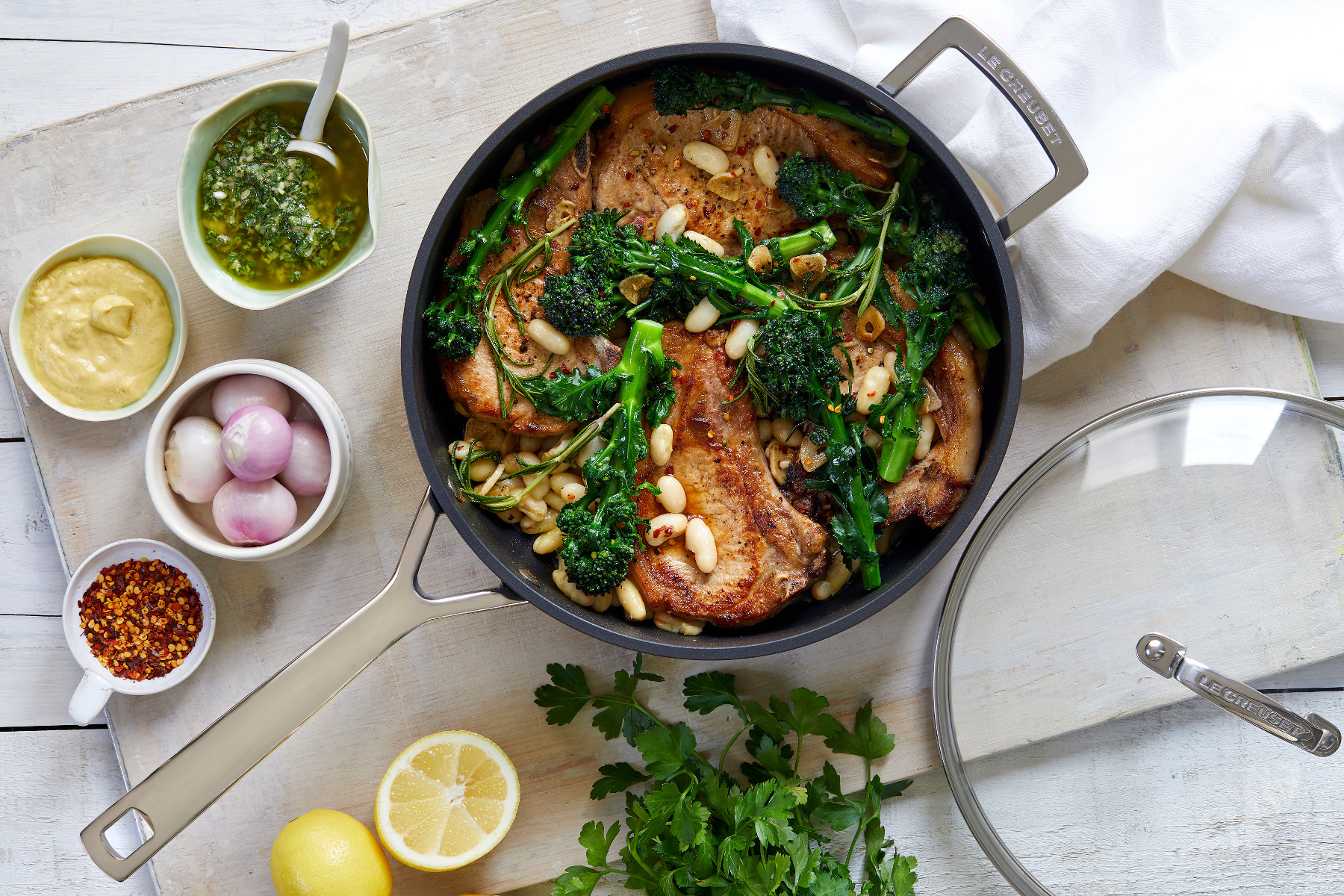
Discover the pleasures of the great outdoors with the new Nature's Kitchen Collection from Le Creuset, make the most of long days and warm evenings surrounded by all that nature has to offer. The new Spring/Summer 2018 collection features Le Creuset's deep, aquatic Marine Blue and fresh Rosemary Geen in its signature Cast Iron, Stoneware, and Salt and Pepper Mills. The collection is complete with Le Creuset's sleeek 3-ply Stainless Steel and Toughened Non-Stick cookware. Whether you grow your own or source locally grown produce, spring is the perfect time to start cooking with the fresh abundance of ingredients and our new delicious recipes make the most ofthe new season's offerings.
Roast Stuffed Leg of Lamb with Beetroot and a Mint, Caper & Honey Sauce
Pork Chops, Purple Sprouting Broccoli and Cannellini Beans with Parsley and Anchovy Sauce
Risotto Primavera (Spring Vegetable Risotto)
Cauliflower Pizza Crust With 4 Toppings
Souffléd Peach and Raspberry Bread and Butter Pudding
Apple, Blackcurrant And Cassis Crumble
Roast Stuffed Leg of Lamb with Beetroot and a Mint, Caper & Honey Sauce

This recipe for a lamb dish is a little different from the usual Easter offering. It uses fresh seasonal beetroot from root to leaves and has Greek inspiration, for whom Easter is the most important religious time in the Christian calendar.
Serves: 6-8
Preparation time: 25 minutes
Cooking time: Approximately 1 ½ hours
INGREDIENTS
1.25kg boned lamb leg
1 tablespoon light olive oil
Salt and pepper
For The Stuffing
60g breadcrumbs
Zest of 1 orange
1 clove garlic, crushed
1 teaspoon chopped thyme leaves
2 teaspoons extra virgin olive oil
Butchers string
2½ tablespoons extra virgin olive oil
2 bunches small to medium beetroot with leaves, peeled and cut into wedges, stalks separated from leaves and chopped
6 cloves garlic, unpeeled and bashed
Peel of half an orange
Juice of half an orange
2 bay leaves
3-4 sprigs thyme
2 tablespoons red wine vinegar
125ml red wine
125ml water
For The Mint Sauce
50g finely chopped mint leaves
2 tablespoons honey
2 tablespoons red wine vinegar
2 tablespoons boiling water
30g nonpareille capers
Salt, to taste

METHOD
Preheat the oven to 180˚C/ Fan 160˚C/ Gas Mark 4
Open out the boned lamb leg and place it skin side down. Trim off any excess sinew and fat and then season well.
Mix all the ingredients for the stuffing together and season. Spread out over the lamb, roll it up and tie it with butcher’s string.
Heat the casserole over medium heat with one tablespoon light olive oil and brown the lamb lightly all over. Put aside.
Mix the beetroot wedges in a bowl with the vinegar, herbs, orange peel and juice, one and a half tablespoons extra virgin olive oil and season.
Heat the casserole, adding the last tablespoon of oil over medium heat. Add the garlic cloves and cook for about a minute before adding the beetroot mixture, the red wine and water. Place the casserole lid on and cook over a medium heat for 10 minutes. Remove from the heat and place the lamb on top.
Place in the oven and bake for about 40-45 minutes for pink lamb or until the center reaches 55˚C measured with a meat thermometer.
- Remove the lamb from the casserole to a plate, cover with foil, then put aside and keep warm. The beetroot will most probably need cooking further. You can increase the oven heat to 200˚C/ 180˚C Fan/ Gas Mark 6 and finish bakinguncovered for a roasted finish. Alternatively, you can put the lid back on and finish cooking over a low to medium heat on the hob. This will take about 10 minutes.
For the mint sauce, mix all the ingredients together in a bowl.
Separately, bring a saucepan of salted water to the boil and cook the stalks and leaves of the beetroot for 10 minutes. The stalks will take longer so add these first. Dress lightly with some more extra virgin olive oil, salt and pepper.
Once everything is ready, remove the string from the lamb and slice. Serve with the beetroot and any juices in the casserole along with the beetroot leaves and stalks and the bowl of mint sauce.
Cook’s notes
If you can’t find beetroot with its leaves attached, just blanch some spinach or Swiss chard to serve as greens instead.
One could skip the stuffing and use a bone in leg of lamb instead, if desired and make the stuffing but bake it until crispy to sprinkle it over the finished dish for a welcome crunch.
Pork Chops, Purple Sprouting Broccoli and Cannellini Beans with Parsley and Anchovy Sauce

Purple sprouting broccoli provides a nice seasonal change from the more usual green broccoli. This recipe is full of flavour and texture, looks impressive served in the large sauté yet takes very little time to make.
Serves: 4
Preparation time: 25 minutes
Cooking time: Approximately 20 minutes
INGREDIENTS
4 bone-in pork chops (approximately 175g each)
2 teaspoons light olive oil
1 teaspoon unsalted butter
Salt and pepper
2 garlic cloves, peeled and finely sliced
3 sprigs rosemary
Pinch chili flakes
400g tin cannellini beans, drained and rinsed
300g purple sprouting broccoli, split down the stalk up to the head
250ml chicken stock
For The Parsley and Anchovy Sauce
15g fresh parsley leaves, with a little of their stalks, finely chopped
Zest of 1 large lemon
1 tablespoon lemon juice
1 teaspoon Dijon mustard
4 anchovy fillets in oil, finely chopped
½ small round shallot, finely chopped
1 clove garlic, crushed or finely grated
3 tablespoons extra virgin olive oil
Salt and pepper

METHOD
Make the parsley and anchovy sauce by mixing all the ingredients and set aside.(be careful with the addition of salt as anchovies are already very salty).
Heat the pan with one teaspoon light olive oil and the butter over a medium heat until the butter is foaming. Season the pork chops, add to the hot pan and brown well on one side. This should take approximately 3 minutes. Reduce the heat to low to medium and turn the chops over and cook for about 3 more minutes or until just done. Remove from the pan, along with any remaining juices, and keep them warm.
Over a low to medium heat, add the other teaspoon of light olive oil to the pan with the sliced garlic, rosemary and chilli flakes.
When the garlic is lightly golden, add the chicken stock and bring to the boil, over a medium heat, with the lid on.
Add the purple sprouting broccoli and replace the lid and simmer for about 5 minutes, turning halfway, until just tender but still with a little bite. Add the cannellini beans and boil rapidly with the lid off to evaporate and concentrate the liquid, stirring occasionally.
Return the pork chops to the pan along with any resting juices, cover and heat through briefly.
Divide the chops, broccoli and beans between plates and spoon the parsley and anchovy sauce over or pass around in a separate bowl.
Cook’s Notes
Pork fillet or lamb chops, leg steaks or neck could also easily replace the pork chops in this recipe.
Chicken breast or thighs would also work well with all the flavours/ingredients.
Swap the cannellini beans for chickpeas if you prefer too.
Risotto Primavera (Spring Vegetable Risotto)

A good risotto should be nicely thickened and creamy, but still be loose enough to flow out and cover the base of a plate when you serve it. Do try to use fresh stock for this as risotto is a dish that is all about the flavour of a really good stock.
Serves: 4
Preparation time: 10 minutes
Cooking time: 25 minutes
INGREDIENTS
2 bunches spring onions, trimmed
150g young carrots, trimmed and scraped clean
1 litre chicken or vegetable stock
200g sugar snap peas
200g freshly shelled petits pois peas
90g butter
225g risotto rice, such as Arborio or Carnaroli
4 tablespoons dry white wine or white vermouth
50g Parmesan cheese, finely grated
The leaves from 15g bunch fresh mint, finely shredded
4 tablespoons crème fraîche, to serve
25g pea shoots or small watercress sprigs, to garnish
Salt and freshly ground white pepper

METHOD
Thinly slice the spring onions, separating the white part from the green. Cut the carrots diagonally into 1cm thick slices and then bring the stock to the boil in a saucepan and keep hot over a low heat.
Drop the sugar snap peas and carrots into a pan of boiling salted water, bring back to the boil and add the shelled peas. Cook for 1 minute then drain. Refresh under cold water then pop open and halve the sugar snaps to expose the peas. Set to one side.
Melt 65g of the butter in the 3-ply Stainless Steel non-stick Chef’s Pan, add the white spring onions and cook gently for 1 minute. Add the rice, then stir to coat all the grains in the butter and cook for 1 minute. Add the white wine and simmer, stirring until it has been absorbed. Add a large ladleful of hot stock and simmer, stirring until it has all been absorbed before adding another. Continue like this, stirring all the time, until the rice is creamy but still with a little bite to it – this should take about 25 minutes. You might not need to use all the stock.
After the risotto has been cooking for 23 minutes, stir in the green spring onion tops with the last addition of stock and cook for 2 minutes more. Stir in the carrots, sugar snap peas, shelled peas and Parmesan cheese and cook for a minute or two to heat them through.
Melt the remaining 25g butter in a small pan and stir in the mint. Stir the mint butter into the risotto, season to taste and spoon onto warmed plates. Spoon over the crème fraîche, scatter with the pea shoots and serve straight away.
Cook’s Notes
This risotto is lovely made with some fresh goat’s cheese. Crumble 100g creamy, rindless goat’s cheese and stir it in at the end with the mint and Parmesan cheese.
Cauliflower Pizza Crust With 4 Toppings

The new, healthy way to make fast, fresh and delicious pizza is with a moreish cauliflower crust and easy-peasy toppings, all made using the Le Creuset Cast Iron 23cm Skillet.
Serves: 4
Preparation time: Approximately 30 minutes
Cooking time: Approximately 30 minutes
INGREDIENTS
Pizza base
250g cauliflower florets
125ml water
2 slightly heaped tablespoons ground almonds
2 slightly heaped tablespoons chickpea flour
1 large egg
1 teaspoon extra virgin olive oil
Salt and pepper
1 teaspoon light olive oil
Topping one
100g Taleggio cheese, sliced
100g prepared grilled artichokes in oil, halved
3 slices Parma ham
Topping two
1 tablespoon light olive oil
200g aubergine, sliced into1½ cm thick rounds
60ml jarred tomato basil sauce
100g mozzarella, sliced and placed on kitchen paper to absorb excess liquid
10g grated pecorino cheese
2 teaspoons extra virgin olive oil
1½ teaspoons chopped basil
Topping three
60g shaved asparagus
½ teaspoon extra virgin olive oil
Salt and pepper
125g ricotta
10g grated Parmesan
1 teaspoon lemon-infused olive oil
1/8 teaspoon chilli flakes
Topping four
80g sun-blush tomatoes (semi-dried marinated tomatoes in oil)
8 anchovy fillets, sliced in half longways
50g pitted black olives
2 teaspoons extra virgin olive oil
1 small clove garlic, crushed
1 teaspoon oregano leaves, chopped
20g rocket
METHOD
Preheat oven to 220˚C / Fan Oven 200˚C / Gas Mark 7
Process the cauliflower quite finely. Place in the skillet with 125ml of water and cook over a low to medium heat until soft and most of the liquid has been absorbed. This will take about 5 to 8 minutes. Alternatively, cook in a bowl in a microwave, covered, with a couple of tablespoons of water. Place in a fine sieve over a bowl to drain. Press lightly to remove any excess liquid.
- In a bowl, whisk the ground almonds and chickpea flour together to remove any lumps. If very lumpy, then sieve. Add the eggand extra virgin olive oil to the bowl and whisk until smooth. Mix this with the cooled cauliflower and season well.
Place your skillet back onto a low to medium heat with the light olive oil and when hot, add the cauliflower mixture, which should sizzle, and spread it over the base and about an inch up the sides of the pan quickly, aided by a spoon. Cook it for about 5 minutes until lightly browned and set underneath, then transfer to the second shelf from the top of the oven and bake for about 10-12 minutes until it is nicely coloured. You may need to turn it half way to cook it evenly.
Remove from the oven and place on your toppings of choice.
Topping one
Place the Taleggio cheese slices and the artichokes on the pizza and return to the oven for about 5 minutes until the cheese is nicely melted. Remove from the oven and top with roughly torn Parma ham.
Cook’s notes
This also works very well with speck instead of Parma ham if you can get it. It is a lightly smoked cured ham form the Alto Adige region of Italy.
A drizzle of rosemary oil is also nice. Mix a teaspoon of extra virgin olive oil with ½ teaspoon of finely chopped rosemary and place it on the pizza either ahead or after cooking.
Another option is to cook a small red onion sliced into rounds in a teaspoon of light olive oil in the skillet ahead of cooking the pizza base. Add the onion with the taleggio and artichokes before finishing with the ham and the rosemary oil, if liked.
Topping two
Cook the sliced aubergine (which will probably need to be done in two batches) in the skillet ahead of cooking your cauliflower base till nicely browned and put aside.
Then proceed from Step 4 above. Place the tomato sauce, mozzarella and then the aubergines on the pizza and put back in the oven for about 8 minutes until the mozzarella is nicely bubbling. Whilst it is cooking mix the olive oil with the chopped basil. Remove the pizza from the oven and drizzle with the basil oil and sprinkle the pecorino cheese over and serve.
Topping three
Season the ricotta with salt and pepper and spread it on the pizza base. Mix the shaved asparagus with the extra virgin olive oil and season and place it on top of the ricotta. Bake for about 8 minutes and then remove from oven. Drizzle the lemon oil over then sprinkle with the chilli flakes and Parmesan cheese.
Cook’s notes
If you can find fresh marjoram, the flavour works well here. Mix about ½ teaspoon of chopped marjoram with the seasoned ricotta before spreading it on the pizza base.
Topping four
For this topping, you will need to bake the pizza base a little longer before adding the topping. Bake the base for 15 minutes at step 3. Once cooked, mix together the oil with the garlic and oregano and spread this over the base. Place the anchovies, sun-blush tomatoes and olives on the pizza and bake for about 5 minutes. Remove from the oven and sprinkle the rocket leaves over.
Cook’s notes
This pizza works well with mozzarella too. Bake the base for only 10-12 minutes in the initial phase. Use about 75-100g of sliced mozzarella and place it on the base then proceed with the rest of the toppings and cook for about 8 minutes until the mozzarella is bubbling. Then finish with the rocket.
Another option is to sprinkle over 10g grated pecorino or Parmesan before serving.
Souffléd Peach and Raspberry Bread and Butter Pudding

The trick to a good bread and butter pudding is not to overload it with bread! This makes it solid and heavy. A good pudding should be light and airy, the thinly cut bread suspended in a lightly set egg custard.
Serves: 4-6
Preparation time: 15 minutes, plus 10 minutes soaking time
Cooking time: 30 minutes, plus grilling time
INGREDIENTS
1 small tin-shaped loaf of fresh white bread
50g soft butter, plus extra for greasing
4 tablespoons good quality lemon curd
1 ripe peach
100g fresh raspberries
250ml creamy milk
250ml double cream
3 medium free-range eggs
25g caster sugar
Finely grated zest 1 large unwaxed lemon
2 tablespoons icing sugar, plus extra for dusting
METHOD
Preheat the oven to 160°C / Fan 140°C / Gas Mark 5
Slice off the end of the loaf and then cut seven 7-8mm thick slices (totalling approximately 180-200g in weight). Stack up the slices, cut off and discard the crusts. Spread generously with the butter and lemon curd and cut each one into 4 triangles.
Grease the inside of the frying pan with a little butter. Halve the peach, discard the stone and cut the flesh into thin slices. Lay 3 slices of the buttered curd triangles over the base of the frying pan and sprinkle over half the raspberries and peach slices. Overlap the rest of the triangles on top, buttered curd-side up, and scatter over the rest of the fruit.
Whisk the milk, cream, eggs, sugar and lemon zest together. Pour it over the top of the bread and leave it to soak for 10 minutes, pushing the top layer down into the liquid now and then so that it soaks up the eggy mixture.
Bake for 30 minutes until it is puffed up and lightly golden. Remove from the oven, and set to one side.
Preheat the grill to high. Dust the top of the pudding with the icing sugar and place the pan under the grill for about 3 minutes until richly golden. Remove, dust once more with icing sugar and serve.
Cook’s Notes
For a nice, extra buttery change, you can make this bread and butter pudding using a loaf shaped brioche instead of white bread.
Take care to keep the top of the pan a minimum of 5cm from the grill heat source.
Apple, Blackcurrant And Cassis Crumble

This is a firm family favourite recipe with a definite grown-up twist. The fruits are poached in the pan, using the glass lid, on the stove-top before the crumble is added and the whole thing baked in the oven. The crumble has oats added which give a delicious and healthy crunch.
Serves: 8
Ingredients
Fruits:
1kg cooking apples
75g golden granulated sugar
175g blackcurrants, topped and tailed
4 tablespoons Cassis liqueur
Crumble topping:
225g plain flour
125g firm butter, diced
75g golden granulated sugar
60g rolled porridge oats
Method
Heat oven to 180˚c / Gas Mark 4, or fan ovens to 170˚c.
Peel, quarter and thickly slice the apples. Transfer to the pan with the sugar and blackcurrants adding 1 tablespoon of water. Cover with the lid and simmer gently for 15 minutes, or until the fruits are softened. Remove from the heat, uncover and cool for 30-40 minutes. Stir in the cassis.
Put the flour and butter into a bowl. Rub the butter into the flour until the consistency resembles breadcrumbs (or process in a food processor for 30 seconds) Stir in all but 1 tablespoon of the sugar and all of the oats. Spoon this evenly over the fruits in the pan. Press down very lightly and sprinkle the remaining sugar over the top.
Bake, uncovered, in the centre of the oven for 20 – 25 minutes, or until the crumble is firm and pale golden brown.
Serve with lightly whipped cream or vanilla ice cream.
Chocolate Italian Panforte

A classic Italian sweet treat with a chocolate twist. Made with a delicious mixture of toasted nuts, glace fruits, honey, sugar and dark chocolate combined with cocoa, flour and spices. Panforte is baked in the oven and has a chewy candy-like texture. It is dusted with icing sugar, cut into small slices and is served after a meal with coffee or with a dessert wine. Panforte is a celebratory sweet, often baked for special occasions and is a great alternative to Christmas cake. It is traditionally baked in a shallow pan making the 3-ply Stainless Steel 24cm non-stick Frying Pan a perfect choice.
Serves: 10-12
Preparation time: 10-15 mins
Cooking time: 30-25 minutes
INGREDIENTS
250g mixed nuts (without shells and husks), Brazils, hazelnuts, almonds, pecans, pistachios are all suitable
115g plain flour
25g cocoa powder
1 teaspoon ground cinnamon
Zest of 1 orange
85g glacé cherries
85g candied orange and lemon peel
100g dark chocolate, melted
2 tablespoons brandy or rum
200g honey
200g light brown sugar
1 tablespoon icing sugar for dusting
A little butter for greasing
Rice paper
INSTRUCTIONS
Oven: 170°C / Fan 150°C / Gas Mark 3, pre-heated.
Place the nuts into the frying pan over a low to medium heat and toast until lightly golden, remove onto a plate, cool and reserve.
Combine the flour, cinnamon, cocoa and orange zest in a medium size, heatproof bowl and stir in the cooled nuts along with the cherries. Set to one side.
Break up the chocolate into small pieces, place into a heatproof bowl and sit over a pan of hot water to melt.
Place the honey and sugar with the brandy or rum into a small pan over a low heat. Once the sugar has melted bring the contents to a slow simmer and cook for 2-3 minutes.
Stir the hot honey syrup and the melted chocolate into the flour and nuts. Combine all the ingredients well.
Lightly grease the frying pan with a little butter and line the base with a disc of edible rice paper. Tip the mixture into the frying pan and use a spatula to smooth over the top.
Bake in the centre of the oven for 30-35 minutes, the mixture will firm up as it cools.
When the panforte is cool, before removing from the pan, dust with icing sugar and serve cut into thin slices.
Cook's Notes
Rice paper makes the sweet easy to handle and is edible. If not available you can use baking parchment but remember to remove it before slicing and serving.
Stored in airtight container this sweet will keep for several weeks.









